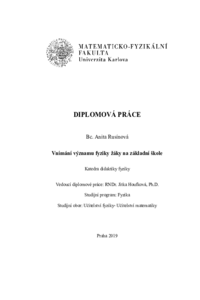Vnímání významu fyziky žáky na základní škole
Perception of the importance of physics by students at elementary school
diplomová práce (OBHÁJENO)

Zobrazit/
Trvalý odkaz
http://hdl.handle.net/20.500.11956/110156Identifikátory
SIS: 180973
Kolekce
- Kvalifikační práce [11242]
Autor
Vedoucí práce
Konzultant práce
Kekule, Martina
Oponent práce
Snětinová, Marie
Fakulta / součást
Matematicko-fyzikální fakulta
Obor
Učitelství fyziky - Učitelství matematiky
Katedra / ústav / klinika
Katedra didaktiky fyziky
Datum obhajoby
16. 9. 2019
Nakladatel
Univerzita Karlova, Matematicko-fyzikální fakultaJazyk
Čeština
Známka
Dobře
Klíčová slova (česky)
vnímání fyziky žáky, pedagogický výzkum, fyzikální pokusyKlíčová slova (anglicky)
perception of physics by students, educational research, physics experimentsCílem této diplomové práce je seznámit se s problematikou a najít možnosti, jak lze ovlivnit vnímání fyziky žáky základní školy. A to metodami použitými ve výuce fyziky. Práce zjišťuje, jak žáci fyziku vnímají, a zkoumá, zda lze vnímání pozitivně ovlivnit využíváním fyzikálních pokusů ve výuce. Práce začíná sestavením vlastního dotazníku Instrinsic Motivation Inventory (IMI). Informace získané z dotazníků byly vzájemně porovnávány a vytvářeny hypotézy. Následovala příprava strukturovaného rozhovoru se žáky základní školy. Výstupy z rozhovorů byly použity k potvrzení či vyvrácení hypotéz. Na základě výsledků vyplývajících z dotazníků a rozhovorů byly formulovány závěry, které lze uplatnit ve výuce, a tak pozitivně ovlivnit vnímání fyziky žáky.
The aim of this diploma thesis is to introduce wayshow teachers can make their elementary school pupils more perceptive to learning physics by the means of specific methods. The thesis first examines on howthe subject is perceived by pupils. It later inquires whether the usage of physical experiments changes how they feel about physics. Initially, the work makes use of an Intrinsic Motivation Inventory (IMI) questionnaire. The collected information is later compared and hypotheses are made. Next, the thesis describes how the structural dialogue with elementary school pupils was prepared and subsequently executed to prove the hypotheses. The questionnaire results put a base to the final conclusions and suggestions which can be applied in a classroom.
